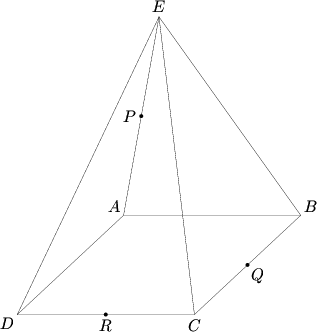Difference between revisions of "2007 AIME I Problems/Problem 13"
(post problem) |
(→Solution: add solution) |
||
| Line 10: | Line 10: | ||
== Solution == | == Solution == | ||
| − | {{ | + | Note first that the intersection is a [[pentagon]]. |
| + | |||
| + | Use 3D analytical geometry, setting the origin as the center of the square base and the pyramid’s points oriented as shown above. <math>A(-2,2,0),\ B(2,2,0),\ C(2,-2,0),\ D(-2,-2,0),\ E(0,0,2\sqrt{2})</math>. Using the coordinates of the three points of intersection (<math>(-1,1,\sqrt{2}),\ (2,0,0),\ (0,-2,0)</math>), it is possible to determine the equation of the plane. The equation of a plane resembles <math>ax + by + cz = d</math>, and using the points we find that <math>2a = d \Longrightarrow d = \frac{a}{2}</math>, <math>-2b = d \Longrightarrow d = \frac{-b}{2}</math>, and <math>-a + b + \sqrt{2}c = d \Longrightarrow -\frac{d}{2} - \frac{d}{2} + \sqrt{2}c = d \Longrightarrow c = d\sqrt{2}</math>. It is then <math>x - y + 2\sqrt{2}z = 2</math>. | ||
| + | |||
| + | Write the equation of the lines and substitute to find that the other two points of intersection on <math>\overline{BE}</math>, <math>\overline{DE}</math> are <math>(\frac{\pm 3}{2},\frac{\pm 3}{2},\frac{\sqrt{2}}{2})</math>. To find the area of the pentagon, break it up into pieces (an [[isosceles triangle]] on the top, an [[isosceles trapezoid]] on the bottom). Using the [[distance formula]] (<math>\sqrt{a^2 + b^2 + c^2}</math>), it is possible to find that the area of the triangle is <math>\frac{1}{2}bh \Longrightarrow \frac{1}{2} 3\sqrt{2} \cdot \sqrt{\frac 52} = \frac{3\sqrt{5}}{2}</math>. The trapezoid has area <math>\frac{1}{2}h(b_1 + b_2) \Longrightarrow \frac 12\sqrt{\frac 52}(2\sqrt{2} + 3\sqrt{2}) = \frac{5\sqrt{5}}{2}</math>. In total, the area is <math>4\sqrt{5} = \sqrt{80}</math>, and the solution is <math>080</math>. | ||
== See also == | == See also == | ||
Revision as of 15:18, 20 March 2007
Problem
A square pyramid with base ![]() and vertex
and vertex ![]() has eight edges of length 4. A plane passes through the midpoints of
has eight edges of length 4. A plane passes through the midpoints of ![]() ,
, ![]() , and
, and ![]() . The plane's intersection with the pyramid has an area that can be expressed as
. The plane's intersection with the pyramid has an area that can be expressed as ![]() . Find
. Find ![]() .
.
Contents |

|
Solution
Note first that the intersection is a pentagon.
Use 3D analytical geometry, setting the origin as the center of the square base and the pyramid’s points oriented as shown above. ![]() . Using the coordinates of the three points of intersection (
. Using the coordinates of the three points of intersection (![]() ), it is possible to determine the equation of the plane. The equation of a plane resembles
), it is possible to determine the equation of the plane. The equation of a plane resembles ![]() , and using the points we find that
, and using the points we find that ![]() ,
, ![]() , and
, and ![]() . It is then
. It is then ![]() .
.
Write the equation of the lines and substitute to find that the other two points of intersection on ![]() ,
, ![]() are
are ![]() . To find the area of the pentagon, break it up into pieces (an isosceles triangle on the top, an isosceles trapezoid on the bottom). Using the distance formula (
. To find the area of the pentagon, break it up into pieces (an isosceles triangle on the top, an isosceles trapezoid on the bottom). Using the distance formula (![]() ), it is possible to find that the area of the triangle is
), it is possible to find that the area of the triangle is ![]() . The trapezoid has area
. The trapezoid has area ![]() . In total, the area is
. In total, the area is ![]() , and the solution is
, and the solution is ![]() .
.
See also
| 2007 AIME I (Problems • Answer Key • Resources) | ||
| Preceded by Problem 12 |
Followed by Problem 14 | |
| 1 • 2 • 3 • 4 • 5 • 6 • 7 • 8 • 9 • 10 • 11 • 12 • 13 • 14 • 15 | ||
| All AIME Problems and Solutions | ||









